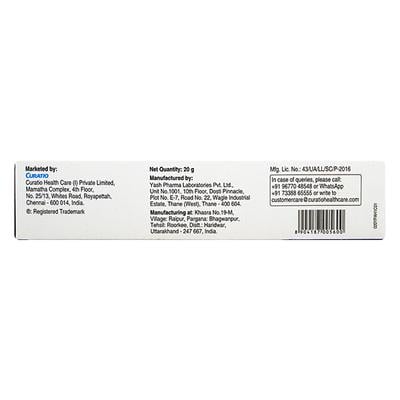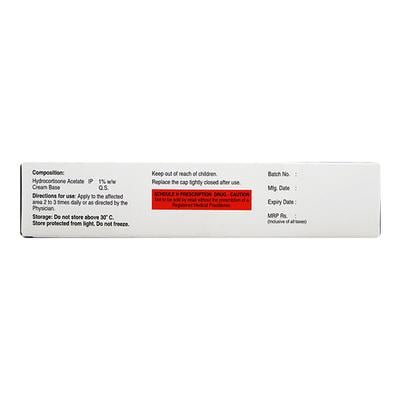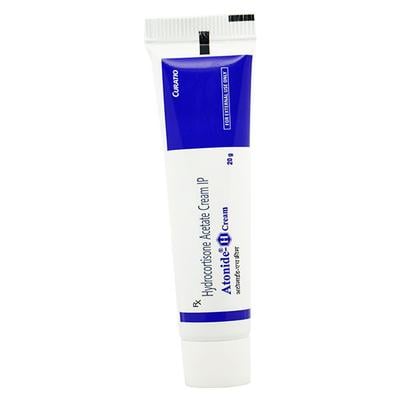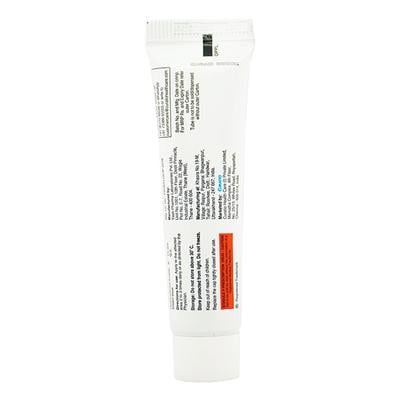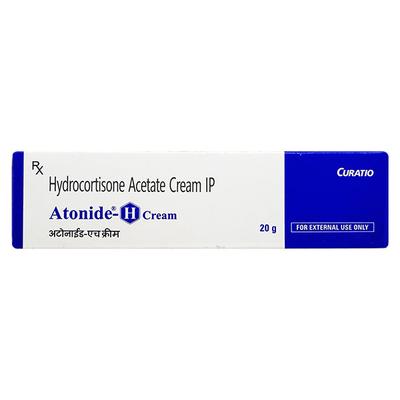

Netmeds First Membership
Quick Links
Introduction About ATONIDE H CREAM
ATONIDE H CREAM contains Hydrocortisone acetate which belongs to the group of medicines called Corticosteroids. ATONIDE H CREAM is used to manage all types of eczema (type of skin inflammation), dermatitis (itching) and insect bite reactions in affected individuals.
ATONIDE H CREAM is not recommended for use in patients allergic to hydrocortisone. It is also not recommended for use in patients with unmanageed skin infection, urticaria (red itchy welts), rosacea (red pus-filled bumps on face), ulcers/infections at the site of management, and psoriasis (itchy skin).
Before applying ATONIDE H CREAM, inform your doctor if you smoke, and/or have tuberculosis, diabetes, and liver disease.
ATONIDE H CREAM should be used with caution in pregnant and breast-feeding women. The medicine is also advised to be used with caution in children and adolescents (aged below 18 years). ATONIDE H CREAM can also be used in elderly patients (aged above 65 years) after consulting the doctor.
The most common side effects of applying ATONIDE H CREAM are atrophy (thinning of muscle tissue), stretch marks, rosacea (red pus-filled bumps on face), perioral dermatitis (inflammation of skin around mouth), acne, and/or purpura (purple coloured rash). Consult your doctor if any of these symptoms worsens.
Uses Of ATONIDE H CREAM
- Manage all types of eczema, dermatitis, and insect bite reactions in affected individuals
How ATONIDE H CREAM Works
ATONIDE H CREAM works by blocking the production of certain chemical messengers (responsible for inflammation and allergies) in the body which results in providing relief from eczema, dermatitis, and insect bite reactions in affected individuals.
How to use ATONIDE H CREAM
Always apply ATONIDE H CREAM as directed by your physician. It is for external use only. Apply a thin layer of this medicine on the affected area. Managed areas on the face should not be covered with a plaster/bandage. Avoid applying this medicine around your eyes, including eyelids. Your doctor will decide the correct dose and duration for you depending upon your age, body weight and disease condition.
Side Effects Of ATONIDE H CREAM
Common
- atrophy (thinning/loss of muscle tissue)
- stretch marks
- rosacea (red puss filled bumps on face)
- perioral dermatitis (inflammation of skin around mouth)
- acne (pimples)
- purpura (purple colored rash)
Uncommon
- hypertrichosis (condition marked by excessive hair growth)
- pigment alteration (post inflammatory skin damage)
- delayed wound healing
- exacerbation of skin infections
Rare
Stop applying ATONIDE H CREAM and contact your physician immediately if you experience any of the following side effects:
- signs of allergic reaction such as reddening of the skin, and/or itching of the skin
Warning & Precautions
Pregnancy
ATONIDE H CREAM should be used with caution during pregnancy and in women planning for pregnancy. Consult your doctor before applying ATONIDE H CREAM.
Breastfeeding
ATONIDE H CREAM should be used with caution in breast feeding women. Consult your doctor before taking the medicine.
Liver
ATONIDE H CREAM should be used with caution in patients with liver diseases. Consult your doctor before applying ATONIDE H CREAM.
Allergy
Do not apply ATONIDE H CREAM if you are allergic to hydrocortisone or any of the other ingredients of this medicine.
Others
ATONIDE H CREAM is not recommended for use if you have:
- unmanageed skin infection
- signs of urticaria (type of allergic reaction) such as pale, reddened patches of skin
- rosacea (red puss filled bumps on face)
- ulcers/infections at the site of management
- psoriasis (itchy skin)
Before taking ATONIDE H CREAM, inform your doctor if you have:
- tuberculosis
- diabetes
Use in Pediatrics:
ATONIDE H CREAM should be used with caution in children and adolescents (aged below 18 years). Consult your doctor before applying the medicine.
Use in Geriatrics:
ATONIDE H CREAM should be used with caution in elderly patients (aged above 60 years). Consult and inform your doctor before applying the medicine.
Interactions
A. Drug-Drug interactions:
Inform your doctor if you are taking, have recently taken or might take any other medicines.
Overdose:
If you or anyone else applied too much of ATONIDE H CREAM or accidentally swallowed the medicine, consult your doctor immediately or visit the nearby hospital to manage the overdose symptoms.
Synopsis
| Drug | : | Hydrocortisone acetate |
| Pharmacological Category | : | Corticosteroid |
| Therapeutic Indication | : | Eczema, Dermatitis, Insect bite reaction |
| Dosage Forms | : | Cream, Foam, Tablet, Injection |
More Information
- Keep the medicine out of reach in children
- Do not store ATONIDE H CREAM above 25°C
FAQs About ATONIDE H CREAM
What is ATONIDE H CREAM used for?
ATONIDE H CREAM contains hydrocortisone acetate which is used to manage all types of eczema (type of skin inflammation), dermatitis (itching) and insect bite reactions in affected individuals.
Who should avoid applying [GBNKEYWORD]?
ATONIDE H CREAM is not recommended for use in patients allergic to hydrocortisone and in patients suffering from unmanageed skin infection, urticaria (type of allergic reaction), rosacea (red puss filled bumps on face), ulcers/infections at the site of management, and/or psoriasis (itchy skin) in affected individuals.
What are the side effects of ATONIDE H CREAM?
The most common side effects associated with the use of ATONIDE H CREAM are atrophy (thinning of muscle tissue), stretch marks, rosacea (red pus-filled bumps on face), perioral dermatitis (inflammation of skin around mouth), acne, and/or purpura (purple coloured rash). Consult your doctor if any of these symptoms worsens.
How ATONIDE H CREAM works?
ATONIDE H CREAM works by blocking the production of certain chemical messengers (responsible for inflammation and allergies) in the body which results in providing relief from eczema, dermatitis, and insect bite reactions in affected individuals.
Can ATONIDE H CREAM be used in pregnant and breastfeeding women?
Yes, ATONIDE H CREAM can be used but with caution in pregnant and breast-feeding women. Consult your doctor before applying ATONIDE H CREAM.
References
1. KD Tripathi. Drugs Acting on Skin and Mucous Membranes. Essentials of medical pharmacology. Seventh edition. 2013 Page: 895.
2. Hydrocortisone acetate. NIH National Library of Medicine. National Center for Biotechnology Information. PubChem. [Revised in July 2022] [Accessed on 27th July 2022] https://pubchem.ncbi.nlm.nih.gov/compound/Hydrocortisone-acetate
3. Arijit Coondoo, Meghana Phiske, Shyam Verma, and Koushik Lahiri. Side-effects of topical steroids: A long overdue revisit. NIH National Library of Medicine. National Center for Biotechnology Information. PMC PubMed Central. [Revised in October 2014] [Accessed on 28th July 2022] https://www.ncbi.nlm.nih.gov/pmc/articles/PMC4228634/
4. Bethesda. Corticosteroids. NIH National Library of Medicine. National Center for Biotechnology Information. [Revised on May 2021] [Accessed on 28th July 2022] https://www.ncbi.nlm.nih.gov/books/NBK548400/
5. Joanne R Chalmers, Emma Axon, Jane Harvey, Miriam Santer, Matthew J Ridd, Sandra Lawton, Sinéad Langan, Amanda Roberts, Amina Ahmed, Ingrid Muller, Chiau Ming Long, Saumya Panda, Pavel Chernyshov, Ben Carter, Hywel C Williams, and Kim S Thomas. Different strategies for using topical corticosteroids in people with eczema. NIH National Library of Medicine. National Center for Biotechnology Information. PMC PubMed Central. [Revised in June 2019] [ Accessed on 28th July 2022] https://www.ncbi.nlm.nih.gov/pmc/articles/PMC6582261/
6. Waymade Plc. Electronic Medicines Compendium (EMC). [Revised in October 2021] [Accessed on 27th July 2022] https://www.medicines.org.uk/emc/files/pil.13103.pdf
Useful Diagnostic Tests
- Patch test









